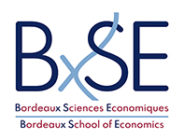Agenda > Tous les événements
Séminaire d’économie de Bordeaux
Andrew Jackson
Université de Surrey
« A stock-flow consistent, input-output framework for the study of energy transitions, stranded assets and transition risk »
Limiting global temperature increases to 2°C above pre-industrial levels will necessitate a transition away from fossil fuels and towards low carbon forms of energy production. While an energy transition is necessary to avoid the catastrophic effects of climate change, it is also likely to lead to the stranding of fossil fuel reserves and capital assets in the energy sector. A concern that is raised in the literature is that asset stranding will negatively affect both the market value of fossil fuel firms and their ability to repay their debts, with any losses potentially negatively affecting other parts of the financial system and the rest of the economy. Although the stranded assets literature is relatively large and varied, only a small number of papers have attempted to investigate the economic effects of stranded assets using an economic model. However, rather than focusing on the financial impacts of asset stranding, these papers tend to focus only on ‘real’ impacts. As such, the modelling of the main mechanism by which stranding is hypothesised to affect the economy – i.e. via the financial markets – remains something of a gap in the literature. We aim to fill this gap by developing a stock-flow consistent (SFC) model with an integrated input-output (IO) model for the study of the economic and financial impacts of energy transitions, capital asset stranding and transition risk. The model is that of a pure credit economy that consists of a household sector, a banking sector, and four firm sectors: a fossil fuel energy sector, a renewable energy sector, a capital goods sector and an ‘other’ firm sector that produces all the non-energy non-capital goods. Novel or semi-novel aspects of the model include multiple firm sectors and goods types, the integration of an input-output model and an almost ideal demand system into the larger SFC model, firms that produce distinct capital vintages which last for a given number of periods and that have endogenously determined levels of labour productivity and material goods inputs, the endogenisation of firms’ markups based on target profit rates, and the tracking of individual loans and loan repayments (with loan defaults that affect the bank’s capital position and so its lending rates). The model is used to investigate the different economic impacts of different types of transitions to a low carbon economy, with the overall macroeconomic impacts depending on the technological differences between green and brown energy production (in terms of capital intensity, energy requirements,etc.),the speed of the energy transition, the degree to which agents are able to anticipate the transition and interactions between the real and financial sides of the economy.



